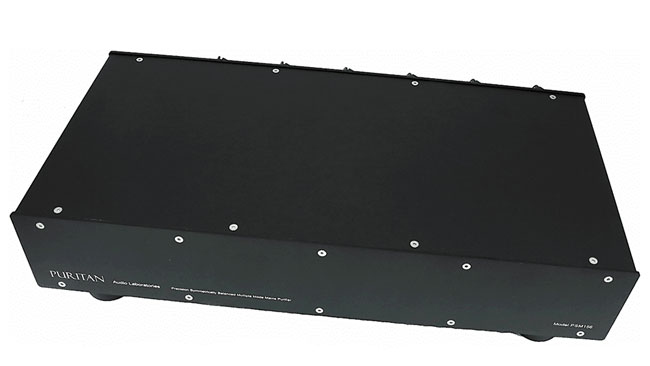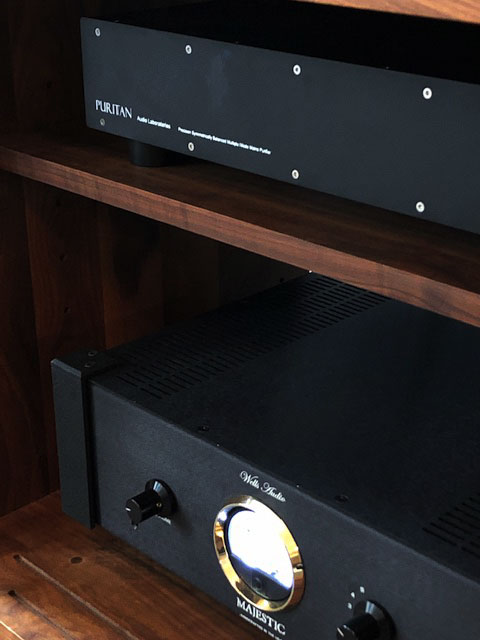Puritan Audio Laboratories PSM156 Power conditioner

 Puritan Audio Labs’ Mike Lester is maybe, the hands down nicest guy in audio. I never even met him. Maybe that’s why I still think that. He’s a lovely emailer and gives even better phone (a dying art to be sure; kinda like our hobby! Rimshot! C’mon, I kid, I kiiiiid!). A gentleman, he agreed to a review of one of his power conditioners by upgrading my request to review one of his lower end wares. I earnestly tried to obtain the cheapest conditioner for review; really I did, but he insisted on sending me, a total stranger without a British accent, his magnum opus, the PSM156. How could I not accept, and happily at that? ‘Twould be gauche! Don’t worry, I will still ruthlessly trash his product if warranted. I have ethics darn it, and a responsibility to my reader(s?), but he really is nice.
Puritan Audio Labs’ Mike Lester is maybe, the hands down nicest guy in audio. I never even met him. Maybe that’s why I still think that. He’s a lovely emailer and gives even better phone (a dying art to be sure; kinda like our hobby! Rimshot! C’mon, I kid, I kiiiiid!). A gentleman, he agreed to a review of one of his power conditioners by upgrading my request to review one of his lower end wares. I earnestly tried to obtain the cheapest conditioner for review; really I did, but he insisted on sending me, a total stranger without a British accent, his magnum opus, the PSM156. How could I not accept, and happily at that? ‘Twould be gauche! Don’t worry, I will still ruthlessly trash his product if warranted. I have ethics darn it, and a responsibility to my reader(s?), but he really is nice.
Did I include honest to a fault? Mike explained he wanted me to hear the 156 in lieu of the other technical expressions of his humanity by sharing with me that “The PS106-DC (about $900.00 USD) is compromised on how we can execute our ideals because of its size constraint and for not much extra the PSM136 delivers much more bang per buck whereas the PSM156 (about $1,850.00 USD) shares most of the 136 but has improved 6 x final stage individual re-filters per output which gets it a little bit cleaner and provides a more effective barrier against individual components plugged in cross interfering with each other.”
The full Monty it was then.
Ok he’s nice. And honest. But nice n’ honest doesn’t cut it round here in the hard knock, dog-eat-possum world of high-end audio (whatever the hell that means anymore). So just why should a discerning bloke like you care what a nice, honest bloke like Mike has to say about silence and power lines? Well for starters, Mike describes himself as “A HiFi obsessive…building my own amps and speakers and collecting mountains of kit since my schooldays. I built my first power conditioner back in 1976 from a practical project published in Brit HiFi Mag ‘HiFi Answers. In those days the emphasis was on clicks and pops and AM radio breakthrough; things you could actually hear ruining your enjoyment.”
“Today,” he continues, “a massive tsunami assault of new noises from the creations of recent decades is in frequency ranges that you can’t hear but boy do they mess your sound up.”
 Ok, so he was interested in HiFi as a lad. Join the club. It’s called “All of Us.”
Ok, so he was interested in HiFi as a lad. Join the club. It’s called “All of Us.”
Ahhhh, but here is where our paths diverged. See, I did NOT work on double super-secret nuclear submarine systems and I don’t care WHAT watch you bought or WHAT you tell women in nightclubs, neither did you. To hear Mike tell it, “Older, with a lab and factory developing and manufacturing super silent (mustn’t let any noise out or the bad guys will find you) lighting controls for nuclear submarines, I had an epiphany moment to turn our noise stopping expertise and facilities to more peaceful and fun activities; stopping noise getting into my and the world’s HiFi’s. And that is how, five years back I arrived at developing and manufacturing mains conditioners, but enough of me…”
See? Now THAT’S an origin story.
“Power Conditioning. What a Contentious Subject!”
The above emboldened line is a direct quote from Mike Lester in his first email to me. Refreshing, I thought. Finally, a self-aware engineer. Even before I could peck out a virtual amen and voice my own past objections to (overly?) “conditioned” power, he had added, “Two major pitfalls that give conditioning a bad name are going too keen with voltage spike clamping by having protection devices hovering over the waveform in danger of clipping at legitimate volts, and designing with the spec sheet in view rather than using your ears at every stage. Achieving more db’s noise reduction for the spec sheet is easy but mostly not desirable. We progressively remove with a gentle touch and from what our users tell us we hit the correct balances with owners overwhelmingly experiencing an uplift in dynamics.”
Imagine that; a power conditioner designed with a “gentle touch!” It’s statistics + humanity, I tells ya. That’s “Humanistics!” Or something like that.
It’s a Giant, All-capturing Antenna!! Run!!!
Really I came to see the 156 as somewhere between a Furman and a Shunyata both in price and in audiophile street cred. In terms of its utilitarian look and no nonsense, unbranded unabashed black boxiness it’s like the former, but with a lot more tech and internals, though not possessed of nearly as much glitz-n-glamor and artisan polished matte aluminum as the latter. Unlike the former, you can’t order it from Bezos and unlike the latter, there aren’t cool full-page ads of men in scrubs using it in a cardiac cath lab. But maybe Mike is working on these things in secret. At least, I hope he is. Really, you can’t do much without Bezos these days. Let us pray.



Now what does this nondescript black box supposedly do for you? Well, do you wanna hear it from a guy who spent his undergrad years writing papers about Emily Dickinson’s concept of death or from a guy who worked on nuclear submarine systems? Ok the sub guy; fine. Regarding the main purpose of getting rid of the noise from the mains, Mike told me EMI (Electromagnetic Interference) is categorized into two types. “Differential or ‘Normal Mode’ is injected into the mains by other connected equipment and this is what hand-held ‘noise sniffers’, Power Line Analysers or Mains Noise Analysers type devices display. They are plugged in by just two wires and hence measure solely the difference in L and N. This is differential mode noise and is by far the easiest to deal with. Our simple plug-in Guardian addresses it very well showing such a convincing result on these test boxes as to lead people to think, it gets rid of all the noise for just $90.00!!” He hastens to add, “sorry wrong.” Damn.
It’s the other type of EMI on the mains; “Common Mode” which Mike says is a “far more pervasive form of EMI and which is very much the primary problem.” He continues, “Common Mode interference is also injected into the mains by connected equipment, particularly those with electronic power supplies and or regulation, which is almost everything today! It also couples in noise from the different stages of the supply wiring route itself and further, gathers noise from the air from the ever increasing barrage from mobile phones, phone masts, WiFi, door openers broadcasts, etc. etc. The massive network of wiring to every socket between the substation and you acts as a giant, all capturing antenna [emphasis mine!] harvesting this rubbish from wherever it can. With so many routes into your HiFi you can see why Common Mode noise is the real Bogeyman that we are dealing with and unfortunately is a hell of a lot more difficult to eradicate, and this is why when you look inside our boxes there is quite a bit going on.”
Now I know what you’re thinking. Or at least, I know what I’M thinking, but Mike is quick to allay purist (read: neurotic) audiophile fears that TOO much might be going on inside his boxes. “It is very easy to ruin the soundscape when filtering noise from the power line and hence this has to achieved with very great care. We established that if we coax the noise out little by little over many carefully tuned, mild stages we lose no life from the sound. Indeed we put quite a bit back into it that was lost in the smog. With our methods though we end up with a much more expensive bill of materials and build time. Our goal though is to deliver this level of engineering and benefit to the end user at real world affordable pricing.”
So there is just enough going on to be dangerous at a reasonable price. But not so much that the soufflé is ruined and Gordon Ramsay yells “bloody murder!” at you.
Condition. Rinse. Repeat.
 Sooooo, confession: the Puritan made me listen to David Crosby. His new album, Here If You Listen, in MQA strikes me as a great bunch of musicians super well-recorded making music which is… well… it has lines like “A balloon on a pin; that’s the place I’m in” and “If you want to write a new story get a new pen.” All around these, umm, “lyrics,” are sparse guitars and pretty voices and an occasional chorus with nary a catchy tune of any kind in sight. Sort of like modern atonal classical music but David Crosby is singing.
Sooooo, confession: the Puritan made me listen to David Crosby. His new album, Here If You Listen, in MQA strikes me as a great bunch of musicians super well-recorded making music which is… well… it has lines like “A balloon on a pin; that’s the place I’m in” and “If you want to write a new story get a new pen.” All around these, umm, “lyrics,” are sparse guitars and pretty voices and an occasional chorus with nary a catchy tune of any kind in sight. Sort of like modern atonal classical music but David Crosby is singing.
I’d heard David Crosby interviewed on NPR, talking about life and the new album. So I queued it up. Now, I wanted to push “stop” on the Audirvana remote, but somehow, even though I wasn’t really into the music here, I couldn’t. I’ll admit it. I was pulled in by the “new and improved” Puritanized sound of my system more so than by the music itself. I will say tracks like the penultimate track “Jamin” (yes, I know L) sounded for the first time in some years in my apartment like actual live music. (Well THAT didn’t take too long! Only like ten years and thousands of dollars)
At the end of the album, which I listened to twice straight through, thank you very much (I do these things for you, dear solitary reader; only for you), you are left thinking “Wow. That was uh… deep? I think?” Or at least I was thinking that. So if you like David Crosby or used to (I’m more of a classical music guy anyway), well hey, I’m just the messenger.
In any case, the new-found separation, the corporeal bodies of singers and guitar and their separation and the space around them was quite evident. At the right volume with this track, you coulda blindfolded me, told me we were in a club, and after I found out how the hell you tied me up and brought me there without me knowing (who owns a car in the city!?), to see DAVID FRIGGIN’ CROSBY, of all people, I would’ve sworn you weren’t lying!
This is sort of revelatory in that I generally hate power conditioners or filters of all sorts in my system. That’s why I’ve lived happily (until now?) with the Naim-approved (gotta be Naim-approved!) Wiremold L1032 passive power strip for ten or so years. Hell, the permanently affixed power cord alone has probably saved me thousands in power cords in that it simply won’t let you put a fancier more expensive one on! (I should probably just send a check straight to Wiremold. I feel better when I spend money on gear). Ok, sometimes I plug a Shunyata Venom Defender into it hoping to be able to spend just a wee bit more money…
Morning Coffee Playlist
 Lykke Li is another artist more popular in gentrifying-area cafés than in my apartment, but I could clearly hear there was cleaner edge definition to her voice on the track “So Sad So Sexy” from her electronicky album of the same name (streamed on Tidal) and I could more clearly make out the faint “back up” chorus (probably her own voice looped in). Again, I just kept going through the whole album. I even explored the follow-up effort “Still Sad Still Sexy.” Yeah; it’s not. Pass.
Lykke Li is another artist more popular in gentrifying-area cafés than in my apartment, but I could clearly hear there was cleaner edge definition to her voice on the track “So Sad So Sexy” from her electronicky album of the same name (streamed on Tidal) and I could more clearly make out the faint “back up” chorus (probably her own voice looped in). Again, I just kept going through the whole album. I even explored the follow-up effort “Still Sad Still Sexy.” Yeah; it’s not. Pass.
Regarding some more usual fare for me, such as Bill Evans’ “How Deep Is the Ocean,” I wrote in my notes, “…absolute clean delimitation of the piano throughout the registers. There is absolutely no roll off! To the contrary there is more edge definition than usual and more pinging hammer strike.” I noted too the images in general here were not as confused. There was a slight fog around things and now if you want to follow them you can.
And there is more height. Yes, on tracks such as “I wish I knew,” the piano is front and center and somehow the image is taller and a bit broader than usual and one even more completely forgets the speakers exist.
Plugging the amp into the Wiremold (with Shunyata Venom Defender plugged into it for good measure) and leaving only the digital to the Puritan, I played through the Beethoven Sonatas for Violin and Piano [Lorenzo Gatto and Julien Libeer via Tidal] to see if my power amp’s dynamics were being in any way restricted. I didn’t notice any dynamic curtailment, but I did immediately notice a ‘whiter shade of pale’ in terms of tonal saturation and a brighter, steelier, less woody string tone. The images were more congealed/blended, with piano bleeding into violin and vice versa. Not bad certainly, just preferable with the total system Puritanized and the difference? Obvious in seconds. I re-Puritanized my Wells amp.

 Now to Angus and Julia Stone’s almost-great album, A Book Like This (lyrics could be a bit more expert/profound in many efforts here), “Choking” is a hauntingly beautiful girl with guitar ‘n drums ballade and it is starkly beautiful. Clarity of voice and snare drum, which was revelatory in terms of its sonic “suchness.” Plucked guitar strings are actually “weighty” and solid and not just twang. The plucked string sound has more heft and her every breath and exhalation is laid bare as is- I suspect- her soul. Rhythm is as it should be, languid, solid and engaging. The maracas as well as her brother’s voice on the next track Bella are right-there-present more so than i’ve heard them before as is his peat-smoke voice which I prefer to her more idiosyncratic one. Reggae-inspired tracks like, “Johnny and June,” fronted by Angus, bounce along buoyantly and toe-tappingly while the soprano chorus sings a “barely there” back up, wayyyyy back somewhere.
Now to Angus and Julia Stone’s almost-great album, A Book Like This (lyrics could be a bit more expert/profound in many efforts here), “Choking” is a hauntingly beautiful girl with guitar ‘n drums ballade and it is starkly beautiful. Clarity of voice and snare drum, which was revelatory in terms of its sonic “suchness.” Plucked guitar strings are actually “weighty” and solid and not just twang. The plucked string sound has more heft and her every breath and exhalation is laid bare as is- I suspect- her soul. Rhythm is as it should be, languid, solid and engaging. The maracas as well as her brother’s voice on the next track Bella are right-there-present more so than i’ve heard them before as is his peat-smoke voice which I prefer to her more idiosyncratic one. Reggae-inspired tracks like, “Johnny and June,” fronted by Angus, bounce along buoyantly and toe-tappingly while the soprano chorus sings a “barely there” back up, wayyyyy back somewhere.
Paul Bley Trio’s, “The Theme,” from their album Bebop was an invitation to a jazz club. Sound was much bigger than it had any right to be on the 5”-woofered Xavians and the drum kit had heft and punch. Throughout the album, Paul’s amazing playing is bejeweled with these tinkling high notes. The first and second tracks of the Bley Trios’ mellow and exciting album, If We May, also showed me high-toned piano glistenings gleanings and decays such that I could be certain the Puritan was allowing all the treble through without sacrifice for the sake of filtration/purity.
Finally, in an attempt to really nail down the percent contribution of the Puritan by system parts, for a couple hours I shamelessly used Igor Levit’s wonderful new Beethoven Piano Sonatas album streamed via Audirvana/Quobuz as my test material. Plugging only my digital front end into the Puritan (with amp running off Ye Olde Venom Defender/Wiremold combo), I got maybe 65-70 percent of the way to the sound of everything Puritanized. Plugging my amp in took me the rest of the way toward clarity. Individual notes were more separated from the ‘herd’ of overtones and hall echo and again, less confused in the mix.
As for dynamics, a major conditioner-related concern for me, in my system I can’t say for sure the PSM156 actually significantly expanded them, but I can say it did them no harm and may actually have improved them somewhat. For me, this would be a first for a power conditioner.
Warning: OSOC (Obligatory Significant Other Confirmation) coming up in 5…4…3…2… Basically, when I said, from the sweet spot this is the best the system has ever sounded, my girlfriend looked up from her laptop and said “mm hmmm.” So there you have it. Either she agreed strongly or was on Instagram looking at a puppy or was completely indifferent. It was certainly one of those.
The Puritans Do Rubber and Wood
Peter Bizlewicz, owner of Symposium Acoustics, knows things about stuff; a lot of things. Prove it? Okay. Peter Bizlewicz on… rubber: “…if you like it, use it. However, I can tell you, categorically, absolutely, objectively and scientifically (are those enough adjectives?) that it is NOT improving accuracy, and is creating temporal distortions that cannot be compensated for other than by its removal (usually, it finds favor as a ‘band aid,’ compensating for edginess, coldness, or aggressive qualities of other things in the system – often, a ‘better’ or more transparent or truthful component or treatment can actually make things sound worse, because it’s letting you hear what’s really there more clearly, and the only cure is to find the culprit that’s causing the bad sound in the first place, and remove it – but this isn’t always easy, or even practical). Having said that, that doesn’t mean rubber feet can’t help, because there are many, many physical, electrical and acoustic factors determining the overall sound quality you’re experiencing (not to mention our own ears and personal preferences), so I am loathe to pronounce that anything is completely bad. Since you value warmth, and it will definitely be increasing that aspect, so you may not mind it. The reality is that we often choose the lesser of two evils, and sometimes, rubber feet, applied in the best place (usually UNDER a platform or damping device) can provide some additional vertical isolation (at a price) which may be salutary to your listening experience, but one must beware of its negative aspects, which includes blurring of details to the point that everything and anything you do to your system makes less and less difference. It’s like looking through a window that’s tinted blue – and you don’t mind it, because you happen to like blue – but the bluer you make the window, the less you see the other colors, and even if blue is your favorite color, perhaps you’d appreciate blue even more with the contrast that other colors, being filtered out by the blue tint, would otherwise provide. And please excuse the crude analogy – but that’s how I’ve come to view my own prejudices regarding sound over the years. My ‘blue’ may be soundstage width, or dynamics, or some other aspect, and sometimes, we get sucked in by our favorite aspect, and it isn’t always good in the long run.”
Need I continue? He can. And at length. Just ask him something about audio.
Trouble is, in my experience he’s usually right. I mean, what he says is usually readily audible to me when I try it. He’s right about rubber. And about his Rollerblock isolation devices and about, well, you get the idea. But what’s he doing in a Puritan Audio power conditioner review? No, Clement didn’t miss anything, you’re still at the right review.
With the Puritan Audio power conditioner, more than ever I was able consistently and easily to discern differences in the materials my trusty Wells Audio amp was situated on. That includes being able to hear quite clearly that rubber sounded exactly like Peter said it would. So did walnut “…warmer than maple because it’s not as hard.” Exactly. And so forth. All instantly apparent along with the broadest stage and most detail I’ve heard from my system when fed with Puritanized power and seated atop Peter’s Rollerblock Juniors with recommended upgraded tungsten ball bearings on top of either his Svelte Shelf Plus or a trio of Fat Padz.
Thusly seated, the drum set on a “A Night in Tunisia” on Paul Bley Trio’s incredible Bebop album was as rock solid and punch-tastic as it can be over a small monitor like my Xavian Perla Esclusiva and his piano has just exactly the right amount of sparkle-to-growl-ratio. Bass was altogether firmer and deeper than with the same amp sitting on two inches of walnut with cork and rubber dampers beneath.
Not only does the Puritan make such comparisons easier to hear in the moment, your system also sounds more consistent hour to hour and day to day because its power is. It becomes in essence a more stable platform and/or test bed.
Because who actually listens to music on their stereo system anyway!? Soooo last century! That’s what iPhones are for.
And So? So “The Crooked Billet at Stoke Rowe”!!
So there it is. After years of building it piece by piece, I’m pretty sure no one would hear my stereo and say, “that sucks!” You might prefer more of this or less of that, but none of you would hate it. Powered through the Puritan, even fewer of you would express a preference for something else. The 156 simply makes the music purer, less congealed and more engaging.
I did find the Audience AR6T conditioner I owned for a time a bit sweeter sounding though less dynamic and detailed and wondered why. Truly? I have no clue, but something I read that Mike said in a 6 Moons’ review registers as a possibility:
“For our own listening appraisals, whilst ‘voicing’ a mains cleaner is a seemingly wrong thing to consider as such a product should not set out to alter tonality, we did note that by removing noise, treble for instance sweetens with fresh detail and nuances revealed whilst stepping up individual filtration stages further could mellow the sound; not unpleasant but we avoided it.” Perhaps that accounts for the mellower sound with the Audience. Perhaps not. And hopefully, 6moons won’t sue StereoTimes for quoting a quote from a review. What a world…
In any case, this maxed-out Puritan for me is a keeper. I told Mike so by email via my noise-generating computer, and I hope to get the chance to tell him in person. See, Mike lives in Oxford and his favorite pub is The Crooked Billet at Stoke Rowe. Founded in 1642, he says it was at one time notorious highwayman Dick Turpin’s hideout (must be a British cowboy). Considerably later, in 1989 in fact, musician Paul Clerehugh hung up his guitar and took the place on, “teaching himself to be a formidable chef and starting his tradition of Music Nights http://www.thecrookedbillet.co.uk/whats-on/music-nights/ where, in very intimate surroundings and with fabulous food, you can be serenaded by some seriously accomplished musicians.”
He added “I urge any of you from across the pond when visiting the UK to make this venue your UK pub experience – you won’t be disappointed particularly if you make it on January 6th when the act performing is Ophelia Ray – my own little baby girl all grown up and fronting her own band.”


“We always seek to provide honest great value with solidly engineered products designed to last a very long time indeed. There are enough regular new flavours of every other component out there crying out for our attention and cash, a mains management solution should be a buy-enjoy-but-just-leave-it-there investment.”
And that’s just what I’ve done; bought it, and now it shall be left there. The Puritan Audio Labs PSM156 is a truly great and solid product, no more or less than what it should be, which sonically speaking, does exactly what its designer says it should and exactly what you’d hoped it would.
So, see you and Mike at the Crooked Billet, lads! We’ll raise a pint and watch some “soccer” together! Cheerio and all that. Til then…
I bid you peace.


David Abramson
Specifications:
Price: $1,875.00 USD
Rated Voltage 110-250v AC 50/60Hz
IEC Type C20 Input
Electrically and magnetically shielded casing.
Dimensions W430, D230, H110.
Manufactured in the UK
5 Years Guarantee
Rebalances the AC sine wave removing DC component, preventing transformer buzz and allowing them to breath properly at full efficiency.
Six 15 Amp Outlets each with independent re-filter stages for both common and differential mode disturbances avoiding cross contamination between connected equipment.
52 cumulative stages of purification removes common and differential mode interference, enhancing clarity, staging and dynamics.
Equal resistance routing to all outputs realizes full dynamic performance.
Integral earth management system inbuilt with cleansed ground and star-earthing format further lowers the noise floor and further enhances clarity and dynamics.
Internal wiring silver plated OFC copper PTFE insulated.
Massive 30,000 amps of three dimensional surge protection
Address:
Puritan Audio Laboratories
Tel: +44-1491-680444
Email: sales@puritanaudiolabs.com
http://www.puritanaudiolabs.com/
Stereo Times Masthead
Publisher/Founder
Clement Perry
Editor
Dave Thomas
Senior Editors
Frank Alles, Mike Girardi, Russell Lichter, Terry London, Moreno Mitchell, Paul Szabady, Bill Wells, Mike Wright, and Stephen Yan,
Current Contributors
David Abramson, Tim Barrall, Dave Allison, Ron Cook, Lewis Dardick, John Hoffman, Dan Secula, Don Shaulis, Greg Simmons, Eric Teh, Greg Voth, Richard Willie, Ed Van Winkle, and Rob Dockery
Site Management Clement Perry
Ad Designer: Martin Perry






Be the first to comment on: Puritan Audio Laboratories PSM156 Power conditioner